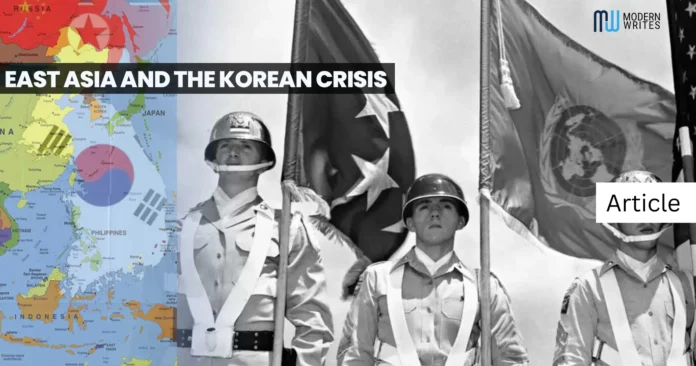Rising Tensions in East Asia
Several land and naval issues simmer in the background throughout East Asia. One of the best threats to world safety and economic increase in 2015 has been highlighted by means of analysts as confrontations between China and its neighbours inside the East and South China Seas. Bloodless conflict-era disputes in East Asia have tested to be just as difficult to remedy. East Asia and the Korean Crisis
For Beijing, Taiwan is an inseparable piece of its overall landmass. As an additional example, there is North Korea, a hermit kingdom armed to the teeth with nuclear bombs. Experts have compared the current situation in East Asia to that of Europe in 1914, citing Pyongyang as the most likely catalyst for the start of a massive military confrontation.
The South China Sea
China, Brunei, Malaysia, the Philippines, and Vietnam are at odds with each other over naval borders inside the South China Sea. The fishing industry and oil and gas reserves also are susceptible to falling into the wrong arms. Three countries—China, Taiwan, and Vietnam—argue about who should control the Paracels. Chinese Taipei, Kuala Lumpur, Manila, Hanoi, and Bandar Seri Begawan all claim territory in the contested Spratly Islands. A few are concerned that Beijing is constructing artificial islands in the area for defense use. To attempt to avert potential battlegrounds, Beijing and its Southeast Asian neighbours have settled on a code of conduct, but many are concerned that it will not be effective. East Asia and the Korean Crisis
The East China Sea
Recurring territorial disputes between Beijing, Tokyo, and Taipei centre on eight remote islands and mountains in the East China Sea. The Japanese refer to them as the Senkaku Islands, the Chinese as the Diaoyu Islands, and the Taiwanese as the Tiaoyutai Islands. The East China Sea coastal border is another contentious issue between Tokyo and Beijing. The conflict over oil and gas reserves is a major concern, just as it was in the South China Sea. The stakeholders recognized the need to develop a “maritime crisis mechanism” in late 2014 to assist in easing hostilities. This system, however, is unstable and has not been well verified.
Taiwan-Chinese conflict East Asia and the Korean Crisis
To entice Taipei into accepting Beijing’s rule, Beijing suggested the “one nation, two systems” solution, under which Taipei would have extensive freedom. Although Taipei turned down the proposal and China maintained its stance that the ROC administration in Taipei is not legal, informal delegates from both countries met for brief discussions anyhow. Tsai Ing-wen, the new president of Formosa, was chosen in 2016 and is in charge of the DPP, an independence-leaning political party.
2018 saw a ratcheting up of language as China intimidated to cut off multinational corporations from doing business in China if they did not include Formosa as an area of China on their internet sites. Many interpreted Ms. Tsai’s staggering 8.2 million votes in 2020 as an insult to China, leading to her re-election. At that point, months of instability and massive protests against the mainland’s expanding power in Hong Kong had passed, and numerous people in Formosa were closely monitoring the situation. Later that year, Hong Kong enacted a national defense statute, perceived as further evidence of China’s claims. East Asia and the Korean Crisis
House Speaker Nancy Pelosi’s tour to Formosa has exacerbated current hostilities between the USA and China. The Chinese authorities consider Taipei to be a colony that broke away from China but will soon return. Nevertheless, many Taiwanese perceive their self-ruled peninsula as a sovereign state, irrespective of any formal declaration of freedom.
Conflict on the Korean Peninsula
As the site of the world’s largest cluster of military personnel, the Korean peninsula is home to about two million servicemen and women. Most analysts agree that Pyongyang possesses nuclear bombs but not yet the rockets to safely launch them. The Republic of Korea is quickly updating its military to become less dependent on American aid.
Both Pyongyang (the Democratic human being’s Republic of Korea) and Seoul (the Republic of Korea) assert their proper to be the only criminal authority in all of the Korean Peninsula, which has led to a long and bloody conflict called the Korean disaster. The America, Beijing, and their allied forces supported Pyongyang throughout the cold conflict, whilst the us and its allied nations supported Seoul.
In 1945, the USA and the USSR split Korea in two. Both great nations set up their separate administrations to reflect their respective values and priorities. The Korean warfare, which started out in 1950 and resulted in 1953, become the end result of growing hostilities. Following the struggle’s end, both international locations were ravaged, however the rift endured. Armed tensions among North and South Korea continued, with occasional outbreaks of violence. As a end result, the struggle has continued even after the bloodless struggle ended.
According to the ROK-US Mutual Defense Treaty, the United States keeps a force existence in South Korea to aid Seoul in times of need. U.S. President Bill Clinton called the Korean Peninsula’s partition in 1997 the “Cold War’s final split.
” U.S. President George W. Bush labelled Pyongyang part of the “axis of evil” in 2002. With its seclusion developing, Pyongyang opted to arm itself with missiles and nuclear weapons. After a yr of escalating tensions, 2018 has visible a series of summits between North and South Korea and America, with the goals of achieving balance and nuclear disarmament.
As a end result, on April 27, 2018, the 2 Koreas signed the Panmunjom assertion, in which they committed to working with each different to demilitarize the island, give a boost to inter-Korean ties, positioned an end to the difficulty, and attempt peacefully towards reunion. When it came to the Seoul army’s White Paper in February 2021, Pyongyang was still not listed as an adversary.
President Moon, who was close to the conclusion of his five-year term, held a forum in late 2021 titled “Declaration of the End of the War: The Limitations and Prospects” to continue his efforts for a diplomatic turning point. However, a few presenters, such as lawmakers from the People Power Party, were hostile to this idea. The North Korean government officially declared itself a nuclear weapons nation on September 9th, 2022.
Role of China, Japan, the USA, and Russia East Asia and the Korean Crisis
There have been substantial shifts in the human, economic, political, and military interactions between nations in northeast Asia as a result of China’s financial ascent and the expanding web of investment and commerce links in the area. The core objectives and strategies of Beijing, Tokyo, Taipei, and Seoul are being affected, as are China’s ties with its neighbours. Using what it calls a “smile strategy,” Beijing is trying to win over its neighbours economically and politically while appearing less aggressive on the battlefield (to everyone but Taipei).
Under the framework of the Six-celebration Negotiations, Washington, Beijing, Tokyo, Moscow, and Seoul are running together to discover a peaceful approach to the North Korean nuclear situation. The amount of cash spent by means of Taiwanese companies on coastal China manufacturing is someplace among $70 and $one hundred billion. About half of China’s exports and imports go through companies with foreign investment. Beijing has surpassed the U.S. as Taipei, Tokyo, and Seoul’s most important commercial allies. Beijing maintains social, financial, administrative, and governmental relationships with Taipei, Tokyo, and Seoul, and also maintains security cooperation with all three.
Based on the nature of the relationship and the nation or country under consideration, the degree of ties can vary from ice cold to scorching hot. In phrases of people, the climate is tepid; in phrases of cash, it is boiling; in terms of international relations, it is bloodless for Taipei however heat for Seoul; and in terms of the army, it’s miles freezing. It is important to awareness at the interconnectedness of the international places in the region, in conjunction with Beijing, Tokyo, Seoul, Pyongyang, and Taipei.
Due to the complexities of global affairs, all international locations are running to improve their relationships with their neighbouring states. The United States has been making a “pivot to Asia” since 2011.
By the year 2020, it intends to station 60% of its naval and air force in Asia. If Taipei, Tokyo, or Seoul are assaulted, it must come to their help under contractual duties. Although Beijing is opposed to the U.S. pivot, it is not interested in an all-out war with the United States. The pivot has the support of several other governments in the area. The United States has been critical of China’s behaviour in the South and East China seas, but it has taken no stance on the land and naval disagreements between the two countries. It urges parties to engage in negotiated settlement to find solutions that are in line with international law.
Nevertheless, as the United States has seen its influence diminish in comparison to Beijing, so has its capacity to exert influence in East Asia. But even at its strongest, the United States was mostly left with less than it had hoped for, as seen by the tepid conclusion to the Korean War and the catastrophic one to the Vietnam War.
To achieve anything near its primary goals in East Asia today, the United States must behave not as a world power or even an imperial state, but as an offshore stabilizer, attempting to keep a rough harmony among rival countries. East Asia and the Korean Crisis
As a result, Moscow was able to stay out of the conflict between the two Koreas in the 1990s, and as a result, it can now reap the political and commercial benefits of that decision. It appears that creative trilateral initiatives in the railway transportation industry and the power sector will provide the most positive results. With a stronger involvement in North Korea’s nuclear disarmament, a demonstration of its willingness to support this procedure, and participation in supplying economic assistance to N. Korea within the structure of multilateral treaties, Moscow could emerge as an “Eurasian bridge,” speeding the advancement of its Far Eastern regions and facilitating its closer cooperation in the Asian economic field.
That is crucial for accomplishing an agreement with the alternative stakeholders involved in the peace efforts (and China and the us in particular) and for convincing them that Moscow does not possess any evil intentions and that its growing presence in Korea will not harm the targets of different actors.





